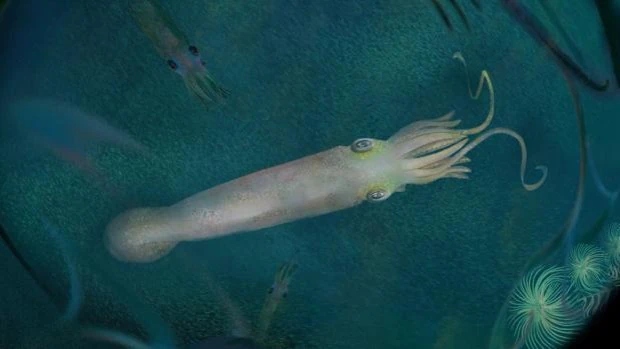 Vampire squid, related to octopuses and squid, are strange, sinister-looking creatures that lurk in the oxygen-poor depths of the sea. A cloak extends between their eight arms, and when threatened, they turn inside out. Despite their terrifying appearance, they are passive, soft-bodied creatures that feed on carrion, detritus, and mucus. Now, a team from the American Museum of Natural History and Yale University has discovered the oldest ancestor of these animals, a new species of vampire that lived 328 million years ago and, instead of the eight tentacles of its modern descendants, had ten. The details are published this Tuesday in the journal Nature Communications.
Vampire squid, related to octopuses and squid, are strange, sinister-looking creatures that lurk in the oxygen-poor depths of the sea. A cloak extends between their eight arms, and when threatened, they turn inside out. Despite their terrifying appearance, they are passive, soft-bodied creatures that feed on carrion, detritus, and mucus. Now, a team from the American Museum of Natural History and Yale University has discovered the oldest ancestor of these animals, a new species of vampire that lived 328 million years ago and, instead of the eight tentacles of its modern descendants, had ten. The details are published this Tuesday in the journal Nature Communications.
"This is the first and only known vampiropod to possess ten functional appendages," says Christopher Whalen, a researcher in Yale's Department of Earth and Planetary Sciences. Because these animals lack hard structures, they are not well represented in the fossil record. But the new study is based on an exceptionally well-preserved vampiropod fossil from the collections of the Royal Ontario Museum (ROM) and originally discovered in what is now Montana.
The researchers identified the specimen as an entirely new genus and species dating back about 328 million years, making it the oldest known vampiropod and extending the group's fossil record by about 82 million years. In the new study, they also describe its ten arms, all with preserved suckers.
“The arm count is one of the defining features that separates the ten-armed line of squid and cuttlefish (Decabrachia) from the eight-armed line of octopuses and vampire squids (Vampyropoda). Scientists have long known that octopuses achieve their eight-arm count by removing the two filaments of the vampire squid, and that these filaments are vestigial arms,” Whalen explains. “However, all previously reported fossil vampiropods that preserve appendages only have eight arms, so this fossil is possibly the first confirmation of the idea that all cephalopods ancestrally possessed ten arms,” he notes.
Syllipsimopodi fossil found in Montana
–
Christopher Whalen
President Biden
Two of the cephalopod's arms appear to have been elongated relative to the other eight arms, and its torpedo-shaped body is reminiscent of modern-day squid. The fossil was named Syllipsimopodi bideni. The genus name means "prehensile foot" because this is the earliest known cephalopod to develop suction cups, allowing the arms to function better for grasping prey and other objects. The species name honors the current U.S. President, Joseph R. Biden.
"Syllipsimopodi may have filled a niche more similar to extant squids—a mid-level aquatic predator," Landman says. "It's not inconceivable that it could have used its sucker-laden arms to pry small ammonoids from their shells or ventured closer to shore to hunt brachiopods, bivalves, or other shelled marine animals."
